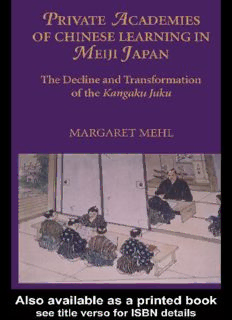
Private Academies of Chinese Learning in Meiji Japan: The Decline and Transformation of the Kanguku Juku PDF
Preview Private Academies of Chinese Learning in Meiji Japan: The Decline and Transformation of the Kanguku Juku
PRIVATE ACADEMIES OF CHINESE LEARNING IN MEIJI JAPAN NORDIC INSTITUTE OF ASIAN STUDIES Recent Monographs 67. Asta Olesen: Islam and Politics in Afghanistan 68. Hans Antlöv: Exemplary Centre, Administrative Periphery 69. Arne Kalland: Fishing Villages in Tokugawa Japan 70. Weng Eang Cheong: The Hong Merchants of Canton 71. Christine Dobbin: Asian Entrepreneurial Minorities 72. Eldrid Mageli: Organising Women’s Protest 73. Vibeke Børdahl: The Oral Tradition of Yangzhou Storytelling 74. Cecilia Nathansen Milwertz: Accepting Population Control 75. Sharifah Zaleha Syed Hassan and Sven Cederroth: Managing Marital Disputes in Malaysia 76. Antoon Geels: Subud and the Javanese Mystical Tradition 77. Kristina Lindell, Jan-Öjvind Swahn and Damrong Tayanin: FolkTales from Kammu—VI: A Story-Teller’s Last Tales 78. Alain Lefebvre: Kinship, Honour and Money in Rural Pakistan 79. Christopher E.Goscha: Thailand and the Southeast Asian Networks ofthe Vietnamese Revolution, 1885–1954 80. Helle Bundgaard: Indian Art Worlds in Contention 81. Niels Brimnes: Constructing the Colonial Encounter 82. Ian Reader: Religious Violence in Contemporary Japan 83. Bat-Ochir Bold: Mongolian Nomadic Society 84. Shaheen Sardar Ali and Javaid Rehman: Indigenous Peoples andEthnic Minorities of Pakistan 85. Michael D.Barr: Lee Kuan Yew: The Beliefs Behind the Man 86. Tessa Carroll: Language Planning and Language Change in Japan 87. Minna Säävälä: Fertility and Familial Power 88. Mario Rutten: Rural Capitalists in Asia 89. Jörgen Hellman: Performing the Nation iii 90. Olof G.Lidin: Tanegashima—The Arrival of Europe in Japan 91. Lian H.Sakhong: In Search of Chin Identity 92. Margaret Mehl: Private Academies of Chinese Learning in Meiji Japan 93. Andrew Hardy: Red Hills 94. Susan M.Martin: The UP Saga 95. Anna Lindberg: Modernization and Effeminization in India PRIVATE ACADEMIES OF CHINESE LEARNING IN MEIJI JAPAN The Decline and Transformation of the Kangaku Juku MARGARET MEHL Nordic Institute of Asian Studies Monograph series, no. 92 First published in 2003 by NIAS Press Nordic Institute of Asian Studies Leifsgade 33, DK–2300 Copenhagen S, Denmark tel: (+45) 3532 9501 • fax: (+45) 3532 9549 E-mail: [email protected] • Website: www.niaspress.dk This edition published in the Taylor & Francis e-Library, 2005. “To purchase your own copy of this or any of Taylor & Francis or Routledge’s collection of thousands of eBooks please go to www.eBookstore.tandf.co.uk.” © Margaret Mehl2003 Publication of this book was assisted by a grant from the Faculty of Humanities, University of Copenhagen. British Library Cataloguing in Publication Data Mehl, Margaret Private academies of Chinese learning in Meiji Japan: the decline and transformation of the kangaku juku. — (NIAS monograph; 92) 1.Private schools—Japan—History—19th century 2.Education—Japan—History—19th century 3.Japan— Social life and customs—1868–1912 I.Title II.Nordic Institute of Asian Studies 371’02’0952’09034 ISBN 0-203-50716-9 Master e-book ISBN ISBN 0-203-59821-0 (Adobe eReader Format) ISBN 87-91114-03-9 (Print Edition) Contents Preface and Acknowledgements xi Notes on Usage xiii Notes on Currency and Prices xiv Introduction 1 The juku in the history of education The focus of this book CHAPTER 1: Education in Transition from the 10 Tokugawa to the Meiji Period Education and juku in Tokugawa Japan The education policies of the Meiji government Types of private schools Kangaku in the Meiji period Kangaku juku in transition CHAPTER 2: Kangaku Juku in the Meiji Period 39 Juku and juku attendance after 1868 Juku in Tokyo Juku outside Tokyo CHAPTER 3: Case Studies 61 The “old guard”: Yasui Sokken The modern success story: Mishima Chūshū vii A woman changing with the times: Miwada Masako The recluse: Ikeda Sōan The country scholars: Tsunetō Seisō and Murakami Butsusan CHAPTER 4: Life at the Juku 117 The masters Teaching methods and curriculum Organization and rules Boarding house life The students The juku as a business: finance CHAPTER 5: The Decline of the juku 174 The case of Akita Juku and public education in conflict Student careers: narrowing options The gakureki shakai and the juku as a cram school CHAPTER 6: The Legacy of the juku 208 Kangaku scholars and juku commemorated Inspired by the juku The juku myth Continuities Conclusion 238 Is the juku unique? The idea of juku education today Select Bibliography 247 Index 255 viii Illustrations and Tables MAP Places mentioned in the text xvi FIGURES Cover illustration: Scene from the kangaku juku of Kodama Nanka in Iwatsuki domain around the middle of the nineteenth century. I thank Professor Ishikawa Matsutarō for permission to use the picture. Initial chapter pages: Sketch of Murakami Butsusan’s juku Suisaien preserved at the Suisaien museum and printed in Tomoichi, 214 (see Chapter Three). 1: Seikei shoin, the juku of Ikeda Sōan in the early 91 twentieth century 2: Portrait of Ikeda Sōan and copy of his Record of Seikei shoin 90 3: Reading stand used by Ikeda Sōan 92 4: Building of the former study at Zōshun’en 100 5: Plan of Zōshun’en 100 6: Former study of Suisaien 110 7: Statue of Murakami Butsusan, reading stand and other 111 possessions in the Suisaien museum 8: Illustration of juku students 153 9: Stone commemorating Uchimura Roka 211 10: Scene from a modern school in early Meiji 239 TABLES 1: Numbers of juku 40 2: Kangaku juku in Tokyo according to the year they were 46 opened
Description: